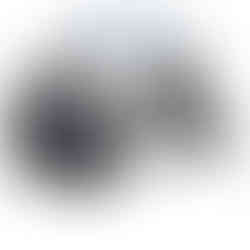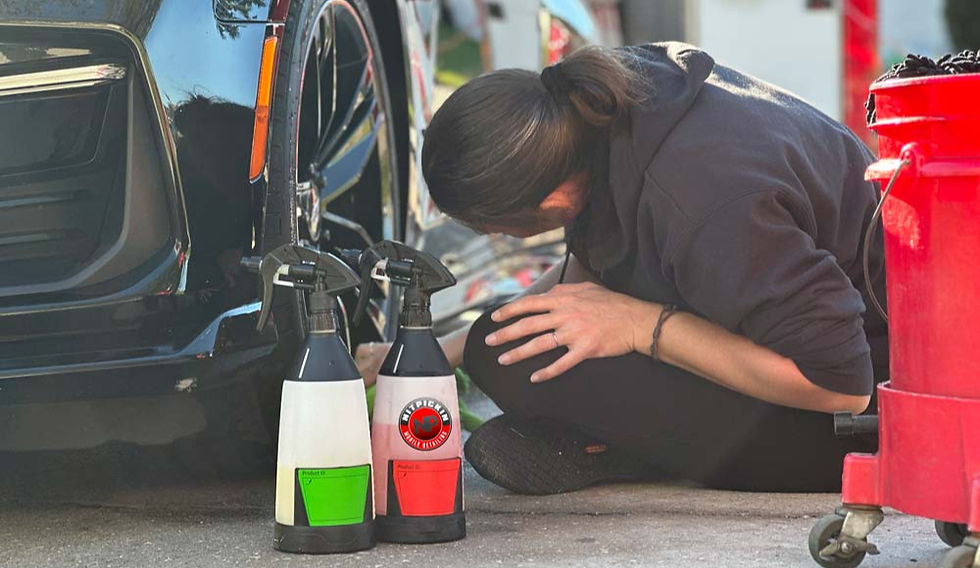Water Treatment for Detailers
- Tommy Trenton Jr

- Jan 14, 2022
- 6 min read
Updated: Apr 9, 2022
This blog is about water spots and how to fight them, so you don't have to deal with them when washing vehicles. There are so many filter systems out there that don't last long enough to hold value. In short, there seems to be mass confusion on what to do about it blah blah blah, but today you will learn about why you get water spots and most importantly, how to put a STOP it today using an RO "Reverse Osmosis" water treatment system. First, this system is primarily for homeowners who wash their vehicles and professional detail businesses that require zero water spotting. If you're not using spot-free water, Id question your professionalism! I'm kidding; we all start somewhere! Ok, so we all know or should know by now about water spots and what they are and how they can wreak havoc on a vehicle's paint and windows. I only assume that you know this because you are here now. If you're ahead of your time, that's awesome, but go back and research water spotting on vehicles! It's worth investigating!

First, this system is primarily for homeowners who wash their vehicles and professional detail businesses that require zero water spotting. If you're not using spot-free water, Id question your professionalism! I'm kidding; we all start somewhere! Ok, so we all know or should know by now about water spots and what they are and how they can wreak havoc on a vehicle's paint and windows. I only assume that you know this because you are here now. If you're ahead of your time, that's awesome, but go back and research water spotting on vehicles! It's worth investigating!
You don't have to be a scientist to know that water spots are a HUGE pain in the ass for every detailer's day-to-day job. So, in short, the TDS level of the water you use to wash a vehicle will determine whether or not you get water spots. TDS can be measured in PPM (Parts Per Million) using a TDS Meter. Here is the meter I use; you can click or tap the link (TDS Meter). I bought it from Amazon.
Understanding how to use your TDS Meter
Fill a container up with water, put your TDS meter up to the fill line, and you will get a PPM reading. Do this with cold, cool, ground temperature, warm, and hot water, then watch how you get different PPM readings with varying water temperatures. The cooler the water, the lower the PPM. The hotter the water, the higher the PPM. Meaning the PPM can fluctuate during different times of the year depending on how cold or hot the climate is. Honestly, don't worry about that, though. I just wanted to bring that little fact to your attention.
The goal is to get your TDS PPM down to around 15 or less to avoid water spots when washing vehicles. My house water/city water averages around 140-190 PPM coming out of my outside faucet. 200 is considered hard water, which is terrible for washing vehicles and most certainly will leave water spots just like the photo below.

WATER SPOTS
If you're a detailer, whether a DIY or a Professional, you know how difficult it can be to avoid water spots. You also understand that removing them can take an arm and a leg if you let it get worse.
HINT: Buy a PRF-RO System...
NOTE: You shouldn't drink anything higher than 500 PPM, and 1000 PPM or higher is deemed unsafe for drinking or cooking.
More about the PRF-RO System
Whether you wash your vehicles or run a detailing business, the best thing you can do to prevent water spots is to buy a PRF-RO System. The problem is the car wash/detailing industry is cloudy on the subject. I have done extensive research on this subject, and my professional advice is, buy a PRF-RO System... My mentors, who have 49 years in the car wash and detailing industry, say the same thing, "use RO water Tommy." Here's their current reference info (Owner, Don Ferguson - Auction Detailing, Clearwater, FL 33762, Email: don.ferguson@auctiondetail.com, Also Owner of Vinyl Magic and Pro Touch USA at www.protouchusa.com)
Anyhow, forget searching for water treatment systems from any of the automotive detail product suppliers. Buy it from a company that only sells systems for treating water. I own the Pentair PRF-RO Reverse Osmosis System, although any PRF-RO System will work the same. Conduct some research, contact some companies and ask some questions. I have it connected to my outside faucet,

which is where I fill my 110-gallon water tank from. I fill my tank once a day. You can google PRF-RO System and get plenty of results. This link (Fresh Water Systems) was given to me by a customer of mine "Keith Johnson," who owns Pool Works in Auburndale, Florida, and has been in the business for 37 years.
Fresh Water Systems has many options that can help you achieve your goal of no water spots. Write Fresh Water Systems an email and tell them your needs and requirements. Tell them how many gallons a day you use. It might be a good idea to purchase the TDS Meter we talked about above and get a reading before you send the Email so you can share that info with them. They will get you set up with the right system that fits your needs. I get zero reference credit for sharing these links. I'm only doing this because I love the industry and want to make it better for everyone.
Steps to getting rid of those stubborn water spots.
Buy a TDS meter.
Test Your TDS level from the faucet you will use to fill your water tank or wash your vehicle.
Contact: Fresh Water Systems
Tell them your goal is to remove water spots for washing vehicles.
Tell them you are relatively new to the subject, but you're looking for a PRF-RO System for your automotive detailing business or for washing your vehicles.
Tell them your TDS level in PPM.
Tell them, on average, how many gallons of water you use each working day.
Ask them about how long it will take to fill your tank/tanks up.
(Based on your water usage) Ask them, on average, with your usage statistics how long the filters should last. NOTE: Your goal should be every 6 to 12 months or longer. Naturally, this depends on the TDS PPM and how many gallons you're using per working day.
Here are photos of my setup
I'm sharing photos because I had to go to a hardware store, "Lowes," and buy a few different fittings/connectors to connect this PRF-RO System to my outside faucet.

I placed my PRF-RO System in a small plastic shed I got from Lowes and drilled a couple of holes in the wall to run the water lines in and out.
I took a small piece of the blue and white hose to Lowes to find the right brass fittings to convert from the stock hose to a slightly larger, more flexible hose connected to a water faucet and a water hose. If your not too savvy with this subject, get someone from your hardware store to help you. I went to the plumbing section ; ) Don't forget to get hose clamps for DIY connections. I apologize for not having the slightest clue as to what the brass parts/fittings are called. Not my field at all, lol. Here are the photos! I'm sure if you showed the guy in the plumbing section at your local hardware store, they would be able to figure it out with you!
PROS AND CONS OF HAVING A PRF-RO SYSTEM
Pros
Zero water spots.
Zero damage left behind from water drying on the surface of your vehicle.
Professional detailing results for your business or DIY hobby.
Less stress when washing vehicles.
Save time and energy by not having to constantly stay ahead of water drying on the surface of a vehicle.
The RO's filters last way longer than other systems making it far more cost-effective for business owners and DIY hobbyists.
You will enjoy washing vehicles again...
Cons
Depending on the system you purchase and how you have it set up, it can take longer to fill your water tank than when you fill your tank straight from a water hose.
My 110-Galon tank takes about 2 1/2 hours to fill to the top with my particular system.
Depending on which system you get, there will be water waste. My system has about 35to40% of water waste that doesn't get used
RO water tends to make your washing soaps less bubbly. So use more soap or fill your wash bucket up with half RO water and half hose water or use straight hose water if that's a factor for you. Just be careful not to let the soapy water dry.
Tips
Fill your foam canon up with hose water instead of RO water.
Mix your presoaks with hose water instead of RO water.
Even though you may use RO water, it's best to blow-dry the entire vehicle immediately after washing it. Sitting water, especially beaded water, will often get contaminated with dust and other particles from the air before they evaporate, leaving spots on the vehicle.
I hope this post clears up some of the madness for you. Feel free to leave a comment with any questions or ideas.



















Як можна зараз багато де почути, що наш світ не може без новин, а людина не може без усвідолення ясностні своїх дій, то це суцільна правда, бо саме завдяки новинам, ми можемо дізнаватися більше, а також більш чіткіше усвідомлювати, що саме відбувається в світі навколо. Я дуже радий, що можу використовувати новинний портал Delo.ua, котрий неаби як змінив моє життя, бо до нього, я навіть подумати не міг, що може бути таке різномаїття інформації. Завдяки ним, я зміг більше дізнатися про крипто-світ, а також про блокчейн https://delo.ua/tags/blokchejn/, що досить таки сильно змінило моє уявлення про те, як все працює. Загалом, я дуже радий тому, що користуюся саме їх порталом новин, бо вони довели своєю працею та якістю, що саме вони…